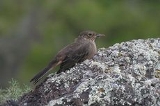
Great Shrike-tyrant
Encyclopedia
The Great Shrike-tyrant (Agriornis lividus) is a species of bird
in the Tyrannidae family.
It is found in Argentina
and Chile
.
It is the largest species of tyrant flycatcher
at 27.5-31 cm (10.8-12.2 in) long. The body weight of this large passerine is reported to average 99.2 grams (3.5 oz.) Its natural habitat
s are subtropical or tropical dry shrubland
, subtropical or tropical high-altitude shrubland, and pastureland.
Bird
Birds are feathered, winged, bipedal, endothermic , egg-laying, vertebrate animals. Around 10,000 living species and 188 families makes them the most speciose class of tetrapod vertebrates. They inhabit ecosystems across the globe, from the Arctic to the Antarctic. Extant birds range in size from...
in the Tyrannidae family.
It is found in Argentina
Argentina
Argentina , officially the Argentine Republic , is the second largest country in South America by land area, after Brazil. It is constituted as a federation of 23 provinces and an autonomous city, Buenos Aires...
and Chile
Chile
Chile ,officially the Republic of Chile , is a country in South America occupying a long, narrow coastal strip between the Andes mountains to the east and the Pacific Ocean to the west. It borders Peru to the north, Bolivia to the northeast, Argentina to the east, and the Drake Passage in the far...
.
It is the largest species of tyrant flycatcher
Tyrant flycatcher
The tyrant flycatchers are a family of passerine birds which occur throughout North and South America. They are considered the largest family of birds on Earth, with more than 400 species. They are the most diverse avian family in every country in the Americas, except for the United States and...
at 27.5-31 cm (10.8-12.2 in) long. The body weight of this large passerine is reported to average 99.2 grams (3.5 oz.) Its natural habitat
Habitat
* Habitat , a place where a species lives and grows*Human habitat, a place where humans live, work or play** Space habitat, a space station intended as a permanent settlement...
s are subtropical or tropical dry shrubland
Shrubland
Shrubland, scrubland, scrub or brush is a plant community characterized by vegetation dominated by shrubs, often also including grasses, herbs, and geophytes. Shrubland may either occur naturally or be the result of human activity...
, subtropical or tropical high-altitude shrubland, and pastureland.

